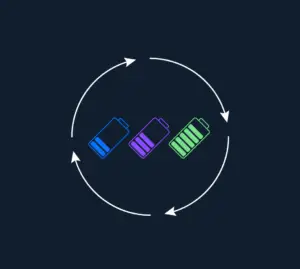The world increasingly relies on rechargeable batteries for its vast and growing energy needs. Batteries power everything from personal electronic devices to vehicles to industrial equipment, and in recent years, they have demonstrated the value they can bring the grid by storing and managing intermittent renewable energy.
Safety is on everyone’s mind, especially when it comes to BESS. A recent Department of Energy funding opportunity announcement noted “battery safety incidents may influence perception of safety of other energy storage systems and limit siting opportunities.” If safety concerns are not addressed directly and credibly, local opposition may increase as new projects are proposed for sites closer to residential and commercial areas. The market is so new that it could only take one high profile incident to negatively affect the way the public thinks about BESS, potentially derailing planned projects and setting back progress to net-zero climate goals.
The rate of adoption is accelerating so quickly that demand for large-scale batteries is expected to grow nearly ninefold between 2023 and 2030. Despite these batteries being all over the place, there has not been a comprehensive approach to safety codes and standards, which is concerning considering when one considers the inherent flammability of lithium-ion batteries (the most common type of rechargeable battery).
The National Fire Prevention Agency (NFPA) is looking to change this with its proposed national standards for battery safety. Tentatively titled NFPA 800 (the Battery Safety Code), this proposed standard would create a comprehensive set of safety requirements for batteries throughout their entire lifecycle. The code would address everything from how materials are sourced, or otherwise acquired, to how these industrial batteries can be safely disposed of.
Let’s take a quick look at where this standard came from and what it may include:
Background and Current State of Battery Safety
Because there is no single, comprehensive set of standards for battery safety, the battery industry has thus far relied on NFPA 855, Standard for the Installation of Stationary Energy Storage Systems, to provide overarching safety guidelines.
NFPA 855 was developed with the intent to mitigate risk and ensure that all battery storage installations are done in a way that takes fire and life safety into consideration. But over time NFPA 855 has become the de-facto standard for general battery safety issues. This has resulted in scope expansion beyond NFPA 855’s original intention, as its standards are now applied to EV batteries and other uses that are not part of stationary energy storage systems.
The need for a general battery safety code ultimately comes down to concerns stemming from lithium-ion battery technology. Fires from batteries with conventional lithium-ion construction can start from physical damage, overcharging or improperly charging, exposure to extreme temperatures, or manufacturing defects. As many as 150,000 incidents have occurred in the past decade, and this number continues to rise as the number of Li-ion battery-powered devices in operation increases.
Clearly, relying on NFPA 855 and an intertwined network of other safety regulations is not sufficient to curb such fundamental fire danger. While the widespread adoption of battery technology has the potential to dramatically reduce fossil fuel dependency and mitigate adverse impacts worldwide, there is a glaring need for better, more comprehensive safety standards.
What to Expect from NFPA 800
The specifics of NFPA 800 are still up for discussion, but you can expect the code to provide uniform requirements for the safe construction, operation, and disposal of batteries. This will include standards for preventing fires, explosions, and other operational hazards. The NFPA has stated that it will look for gaps in the current system of standards and create guidelines to mitigate the dangers created by these gaps.
NFPA 800 will set standards across the entire lifecycle of a battery, which include:
- Battery Manufacturing: Ensuring that batteries are produced in accordance with stringent safety standards is crucial to minimizing the risk of defects that could lead to fires or explosions. NFPA 800 will likely create guidelines for quality control, testing, and the certification of battery manufacturing processes.
- Battery Storage: Proper storage of lithium batteries helps to prevent accidents, particularly in industrial and commercial settings that may be collocating large quantities of batteries. You can expect NFPA 800 to address storage solutions including temperature control, ventilation, and fire suppression systems.
- Transport of Batteries: The transportation of batteries, especially those containing hazardous materials, poses significant safety challenges. NFPA 800 will likely provide guidelines for the safe handling and transport of batteries, including packaging requirements, warning labels, and more.
- Product Manufacturing: NFPA 800 standards may apply to products with integrated batteries, like many portable electronic devices. Expect to see standards related to design, testing, and safety certifications for products with built-in batteries.
- Installation, Use, and Maintenance (including infrastructure): Safe installation and use of batteries are critical to preventing accidents. Regular maintenance may also be required to ensure that a battery system remains safe throughout its operational life. The new NFPA code is expected to include robust guidelines for all of this.
- Worker Safety: The NFPA will seek to protect workers who handle, assemble, or maintain batteries. You can expect safety protocols, such as using personal protective equipment (PPE), and training on safe handling of batteries.
- Emergency Response: Li-ion battery fires present unique hazards and challenges. The fires produce toxic gases and carry risks of explosion or electrocution. They also burn at extremely high temperatures and are prone to reigniting hours, days or weeks later, as the battery’s chemical components can’t be “starved out” like other fires. Because of this, NFPA safety regulations will likely include guidelines for both preventing and responding to emergency situations. For example, they could require battery-dependent facilities to display specific warning labels and have fire extinguishers and other safety equipment on site.
- Second Use, Battery End of Life, Disposal, or Recycling: Batteries must be properly disposed of (or recycled safely) to prevent environmental contamination and reduce the risk of accidents. NFPA 800 should describe standards for the safe disposal and recycling of batteries, including guidelines for the handling of hazardous materials.
The Future of Battery Safety
There are other steps the NFPA could take in addition to the ones proposed. When developing new safety standards for BESS projects, it might be prudent to establish a set of criteria specific to individual use cases (or sets of use cases) rather than focusing on individual battery technologies. This could help AHJs take a technology-agnostic approach to evaluating proposed BESS projects, as well as provide flexibility for new battery options as they come to market.
As an example, guidelines for BESS projects in urban areas may stipulate that a battery system experiencing a thermal event (including a fire) cannot produce toxic gases that endanger local residents, and that a fire cannot propagate to other BESS units. In contrast, guidelines for BESS projects in rural areas may be less strict when it comes to fire issues, and only require that they be sited a minimum distance from residential and commercial areas.
This kind of approach would help to simplify permitting and enforcement in situations where a project owner opts for a technology with a high safety profile, and potentially make it possible for AHJs to allow future BESS installations in areas where they are disallowed today.
As the first official set of comprehensive guidelines, NFPA 800 marks a pivotal moment in the evolution of battery safety standards, but it also underscores the inherent dangers of certain battery technologies that warrant such standards in the first place. Regardless, having a uniform safety code will significantly reduce the associated risks while supporting the industry’s continued growth, which is a benefit for all. We expect NFPA 800 to be a comprehensive, forward-looking code that addresses every stage of a battery’s lifecycle, from production to disposal. It will serve as a vital framework to reduce the number and frequency of lithium-ion battery fires in an overarching effort to make the energy transition as safe as it is transformative.




